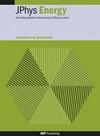Scalable and cost-effective fabrication of high-performance self-powered heterojunction UV-photodetectors using slot-die printing of triple-cation lead perovskite coupled with triboelectric nanogenerators
IF 6.3
3区 材料科学
Q1 ENERGY & FUELS
引用次数: 0
Abstract
The demand for continuous monitoring of ultraviolet (UV) radiation, which poses significant health risks, has grown significantly with the advent of the internet of things (IoT) for human health. The need for a self-powered system that does not rely on battery charging in environmental conditions has led to the exploration of triboelectric nanogenerators (TENGs) as a promising energy source for sensor systems. In this study, we present a fully printed UV photodetector (UV-PD) that is fabricated through scalable slot-die printing of either single-layer triple-cation mixed halide perovskite (TCMHP) or a heterojunction of TiO2/TCMHP on patterned fluorine-doped tin oxide (FTO). The integrated TENG generates the required energy from the tapping of Kapton to the FTO contact, making the device self-powered. Our self-powered PD exhibits an excellent responsivity and detectivity of 71.4 mA W−1 and 6.92 × 1010 Jones, respectively, under a 395 nm wavelength, significantly outperforming spin-coated TCMHP-based devices. We further optimized the performance of our integrated TENG-powered heterojunction TiO2/TCMHP UV-PD by fabricating sensors with groove spacings of 2, 3, 5, and 8 mm. The optimized device demonstrated an unprecedented responsivity, detectivity, and EQE% of 151.9 mA W−1, 1.29 × 1011 Jones, and 47.8%, respectively, under UV irradiation. Our work represents a significant step towards large-scale industrial flexible self-powered UV detection devices that can protect human health and safety. This study highlights the potential of scalable and cost-effective slot-die printing techniques for the industrial production of high-performance self-powered UV sensors, with significant implications for IoT-based health monitoring and environmental protection applications.利用槽模印刷三阳离子铅包晶石和三电纳米发电机,以可扩展和具有成本效益的方式制造高性能自供电异质结紫外光光电探测器
紫外线(UV)辐射会对人体健康造成严重危害,随着人类健康物联网(IoT)的出现,对紫外线(UV)辐射进行连续监测的需求大幅增长。由于需要一种在环境条件下不依赖电池充电的自供电系统,人们开始探索将三电纳米发电机(TENGs)作为传感器系统的一种有前途的能源。在这项研究中,我们介绍了一种完全印刷的紫外光探测器(UV-PD),它是通过在图案化的掺氟氧化锡(FTO)上印刷单层三阳离子混合卤化物包晶石(TCMHP)或 TiO2/TCMHP 异质结而制成的。集成的 TENG 可从 Kapton 与 FTO 接触点的接触中产生所需的能量,从而使器件实现自供电。我们的自供电 PD 在 395 nm 波长下表现出卓越的响应度和检测度,分别为 71.4 mA W-1 和 6.92 × 1010 Jones,大大优于基于旋涂 TCMHP 的器件。通过制造槽间距为 2、3、5 和 8 毫米的传感器,我们进一步优化了集成 TENG 动力异质结 TiO2/TCMHP UV-PD 的性能。优化后的器件在紫外线照射下显示出前所未有的响应度、检测度和 EQE%,分别为 151.9 mA W-1、1.29 × 1011 Jones 和 47.8%。我们的工作标志着向保护人类健康和安全的大规模工业灵活自供电紫外线检测设备迈出了重要一步。这项研究凸显了可扩展且经济高效的槽模印刷技术在工业化生产高性能自供电紫外线传感器方面的潜力,对基于物联网的健康监测和环境保护应用具有重要意义。
本文章由计算机程序翻译,如有差异,请以英文原文为准。
求助全文
约1分钟内获得全文
求助全文
来源期刊

Journal of Physics-Energy
Multiple-
CiteScore
10.90
自引率
1.40%
发文量
58
期刊介绍:
The Journal of Physics-Energy is an interdisciplinary and fully open-access publication dedicated to setting the agenda for the identification and dissemination of the most exciting and significant advancements in all realms of energy-related research. Committed to the principles of open science, JPhys Energy is designed to maximize the exchange of knowledge between both established and emerging communities, thereby fostering a collaborative and inclusive environment for the advancement of energy research.
 求助内容:
求助内容: 应助结果提醒方式:
应助结果提醒方式:


